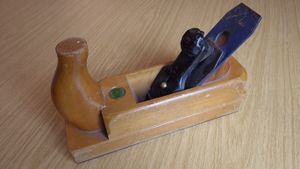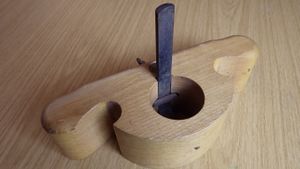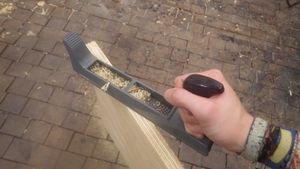Hand Planes: Difference between revisions
(few more sections, still stub!) |
(infoboxes and short texts for our bench planes) |
||
| Line 1: | Line 1: | ||
Planes are essential in many (hand tool) [[:Category:Woodworking|woodworking]] projects. Because proper sharpening is a ton of work that is easily ruined in a few seconds, using the shared planes in the [[Wood Workshop|wood workshop]] requires an introduction by a [[tutor]]! | |||
== Smoothing Plane == | In addition, you may want to have a look at this [https://www.youtube.com/watch?v=psoD4mMsiDQ video class] (about 20 minutes in) to learn how to tune and sharpen them or this [https://www.youtube.com/watch?v=2iXhRBtTr60 video explaining different styles of hand planes]. | ||
== Bench Planes == | |||
Bench planes are made for flattening surfaces and are typically used at a [[workbench]] because you want your workpiece to held steady. | |||
The typical order of use (from rough to fine work) is [[Scrub Plane|scrub plane]] - [[Jack Plane|jack plane]] - [[Jointer Plane|jointer plane]] - [[Smoothing Plane|smoothing plane]]. | |||
=== Scrub Plane === | |||
{{ToolInfoBox | {{ToolInfoBox | ||
|tool name= | |tool name=Scrub Plane | ||
|image= | |image= | ||
|synonyms= | |synonyms=DE: Schrupphobel | ||
|type=hand tool | |type=hand tool | ||
|access=upon introduction | |access=upon introduction | ||
| Line 12: | Line 19: | ||
|tutors=[[Lukas]] | |tutors=[[Lukas]] | ||
}} | }} | ||
Scrub planes are made for aggressive material removal, e.g. when you need to get rid of cupping or twisting in a board, and have a rounded blade to avoid tearing the wood next to the thick shaving. | |||
<br clear=all> | <br clear=all> | ||
== '' | === Jack Plane === | ||
{{ToolInfoBox | |||
|tool name=Jack Plane | |||
|image= | |||
|synonyms=fore plane, "No. 5", "No. 6"; DE: Schlichthobel | |||
|type=hand tool | |||
|access=upon introduction | |||
|location=[[Wood Workshop|wood workshop]] | |||
|material=[[wood]] | |||
|tutors=[[Lukas]] | |||
}} | |||
The "jack of all trades" among planes is of intermediate size and aggressiveness. You may want to use a scrub plane in advance (depending on your stock) and follow it up with a [[Jointer Plane|jointer plane]] and possibly also a [[Smoothing Plane|smoothing plane]]. | |||
Many jack planes have a double iron ("chipbreaker"/''Spanbrecher'' -> ''Doppelhobel'') on top of the blade which breaks the shaving - these are better suited for working across the grain as there is a reduced risk of tearout. | |||
== Jointer Plane == | If you don't have a [[jointer]] or jointer plane at hand, it's possible to [https://www.youtube.com/watch?v=ddCHG6RddI4 joint edges by hand] with a small plane like this (with a little practice)! | ||
<br clear=all> | |||
=== Jointer Plane === | |||
{{ToolInfoBox | {{ToolInfoBox | ||
|tool name=Jointer Plane | |tool name=Jointer Plane | ||
|image= | |image= | ||
|synonyms=DE: Raubank | |synonyms="No. 7", "No. 8"; DE: Raubank,<br>Rauhbank, "Fugbank" (even longer) | ||
|type=hand tool | |type=hand tool | ||
|access=upon introduction | |access=upon introduction | ||
| Line 32: | Line 54: | ||
|similar=[[jointer]] | |similar=[[jointer]] | ||
}} | }} | ||
This huge type of plane is useful for creating large even surfaces and to [[joint]] boards before assembly or gluing, i.e. to create ''perfectly'' flat and perpendicular edges. | |||
<br clear=all> | |||
=== Smoothing Plane === | |||
{{ToolInfoBox | |||
|tool name=Smoothing Plane | |||
|image=Wooden smoothing plane.JPG | |||
|synonyms="No. 3", "No. 4"; DE: Putzhobel | |||
|type=hand tool | |||
|access=upon request | |||
|location=Lukas' [[CoMaking bench]] | |||
|material=[[wood]] | |||
|tutors=[[Lukas]] | |||
}} | |||
Lukas has an old Ulmia smoothing plane with a screw instead of a wedge and a metal sole. This kind of plane is designed to take of very fine shavings towards the finalization of your piece. | |||
"Reform" models are named after an adjustable section of the sole.<sup> [https://www.holzwerken.de/museum/bankhobel/putzhobel2.phtml]</sup> | |||
To retract the blade, loosen the set screw a tiny bit, hold the plane in one hand and hit the metal button at the thick end with a [[Hammers|hammer]]. | |||
<br clear=all> | |||
== Rabbet Plane == | |||
{{ToolInfoBox | |||
|tool name=Rabbet Plane | |||
|image= | |||
|synonyms=rebate plane, DE: Falzhobel | |||
|type=hand tool | |||
|access=upon introduction | |||
|location=[[Wood Workshop|wood workshop]] | |||
|material=[[wood]] | |||
|tutors=[[Lukas]] | |||
|similar=[[router]] | |||
}} | |||
A rabbet plane is used to cut rabbets, i.e. a "step" at the edge, into wood. | |||
Further reading: [https://en.wikipedia.org/wiki/Rebate_plane Wikipedia] | |||
<br clear=all> | <br clear=all> | ||
| Line 40: | Line 99: | ||
|tool name=Router Plane | |tool name=Router Plane | ||
|image=Router plane.JPG | |image=Router plane.JPG | ||
|synonyms=hand router; DE: | |synonyms=hand router; DE: Grundhobel | ||
|type=hand tool | |type=hand tool | ||
|access=upon | |access=upon introduction | ||
|location=[[Wood Workshop|wood workshop]] | |location=[[Wood Workshop|wood workshop]] | ||
|material=[[wood]] | |material=[[wood]] | ||
|tutors= | |tutors=[[Lukas]] | ||
|similar=[[router]] | |similar=[[router]] | ||
}} | }} | ||
Used for smoothing grooves and recesses - for large or repetitive jobs, you'd rather use a power [[router]] nowadays. | Used for smoothing grooves and recesses - for large or repetitive jobs, you'd rather use a power [[router]] nowadays. | ||
Our router plane has not been commissioned yet and '' | Our router plane has not been commissioned yet and ''desperately'' needs some sharpening! | ||
<br clear=all> | <br clear=all> | ||
| Line 66: | Line 125: | ||
|similar=[[rasps]] | |similar=[[rasps]] | ||
}} | }} | ||
Short for "'''sur'''face '''form'''ing" plane, a surform plane closely resembles a [[rasp]]. Use it for fairly quick and aggressive material removal, but don't expect a silky finish! | Short for "'''sur'''face '''form'''ing" plane, a surform plane closely resembles a [[rasp]]. Use it for fairly quick and aggressive material removal, but don't expect a silky finish! The "blade" needs to be exchanged when it becomes dull. | ||
Other than single-blade planes, this one is somewhat decent for shaping [[plywood]]. | |||
<br clear=all> | <br clear=all> | ||
| Line 72: | Line 133: | ||
== Further Reading == | == Further Reading == | ||
* Dictum: [https://www.dictum.com/de/werkzeuge/holzbearbeitung-metallbearbeitung/hobel#experten "Expertenwissen - Hobel" (DE)] or [https://www.dictum.com/en/tools/woodworking-metalworking/planes#expert "Expert knowledge - Planes" (EN)] with terminology of parts and some information about bevels and cutting angles | * Dictum: [https://www.dictum.com/de/werkzeuge/holzbearbeitung-metallbearbeitung/hobel#experten "Expertenwissen - Hobel" (DE)] or [https://www.dictum.com/en/tools/woodworking-metalworking/planes#expert "Expert knowledge - Planes" (EN)] with terminology of parts and some information about bevels and cutting angles | ||
* Wikipedia: [https://en.wikipedia.org/wiki/Plane_(tool) "Plane (tool)" (EN)] or [https://de.wikipedia.org/wiki/Hobel "Hobel" (DE)] | |||
[[Category:Hand Tools]] | [[Category:Hand Tools]] | ||
[[Category:Woodworking]] | [[Category:Woodworking]] | ||
Revision as of 18:17, 13 November 2017
Planes are essential in many (hand tool) woodworking projects. Because proper sharpening is a ton of work that is easily ruined in a few seconds, using the shared planes in the wood workshop requires an introduction by a tutor!
In addition, you may want to have a look at this video class (about 20 minutes in) to learn how to tune and sharpen them or this video explaining different styles of hand planes.
Bench Planes
Bench planes are made for flattening surfaces and are typically used at a workbench because you want your workpiece to held steady.
The typical order of use (from rough to fine work) is scrub plane - jack plane - jointer plane - smoothing plane.
Scrub Plane
| ToolInfoBox Scrub Plane | |
|---|---|

| |
| Synonyms: | DE: Schrupphobel |
| Type: | hand tool |
| Material: | wood |
| Location: | wood workshop |
| Access Requirements: | upon introduction |
| Tutors: | Lukas |
Scrub planes are made for aggressive material removal, e.g. when you need to get rid of cupping or twisting in a board, and have a rounded blade to avoid tearing the wood next to the thick shaving.
Jack Plane
| ToolInfoBox Jack Plane | |
|---|---|

| |
| Synonyms: | fore plane, "No. 5", "No. 6"; DE: Schlichthobel |
| Type: | hand tool |
| Material: | wood |
| Location: | wood workshop |
| Access Requirements: | upon introduction |
| Tutors: | Lukas |
The "jack of all trades" among planes is of intermediate size and aggressiveness. You may want to use a scrub plane in advance (depending on your stock) and follow it up with a jointer plane and possibly also a smoothing plane.
Many jack planes have a double iron ("chipbreaker"/Spanbrecher -> Doppelhobel) on top of the blade which breaks the shaving - these are better suited for working across the grain as there is a reduced risk of tearout.
If you don't have a jointer or jointer plane at hand, it's possible to joint edges by hand with a small plane like this (with a little practice)!
Jointer Plane
| ToolInfoBox Jointer Plane | |
|---|---|

| |
| Synonyms: | "No. 7", "No. 8"; DE: Raubank, Rauhbank, "Fugbank" (even longer) |
| Type: | hand tool |
| Material: | wood |
| Location: | wood workshop |
| Access Requirements: | upon introduction |
| Tutors: | Lukas |
| Similar (More or Less): | jointer |
This huge type of plane is useful for creating large even surfaces and to joint boards before assembly or gluing, i.e. to create perfectly flat and perpendicular edges.
Smoothing Plane
| ToolInfoBox Smoothing Plane | |
|---|---|

| |
| Synonyms: | "No. 3", "No. 4"; DE: Putzhobel |
| Type: | hand tool |
| Material: | wood |
| Location: | Lukas' CoMaking bench |
| Access Requirements: | upon request |
| Tutors: | Lukas |
Lukas has an old Ulmia smoothing plane with a screw instead of a wedge and a metal sole. This kind of plane is designed to take of very fine shavings towards the finalization of your piece.
"Reform" models are named after an adjustable section of the sole. [1]
To retract the blade, loosen the set screw a tiny bit, hold the plane in one hand and hit the metal button at the thick end with a hammer.
Rabbet Plane
| ToolInfoBox Rabbet Plane | |
|---|---|

| |
| Synonyms: | rebate plane, DE: Falzhobel |
| Type: | hand tool |
| Material: | wood |
| Location: | wood workshop |
| Access Requirements: | upon introduction |
| Tutors: | Lukas |
| Similar (More or Less): | router |
A rabbet plane is used to cut rabbets, i.e. a "step" at the edge, into wood.
Further reading: Wikipedia
Router Plane
| ToolInfoBox Router Plane | |
|---|---|

| |
| Synonyms: | hand router; DE: Grundhobel |
| Type: | hand tool |
| Material: | wood |
| Location: | wood workshop |
| Access Requirements: | upon introduction |
| Tutors: | Lukas |
| Similar (More or Less): | router |
Used for smoothing grooves and recesses - for large or repetitive jobs, you'd rather use a power router nowadays.
Our router plane has not been commissioned yet and desperately needs some sharpening!
Surform Plane
| ToolInfoBox Surform Plane | |
|---|---|

| |
| Synonyms: | DE: Surform-Hobel |
| Type: | hand tool |
| Material: | wood |
| Location: | wood workshop |
| Access Requirements: | upon reading |
| Similar (More or Less): | rasps |
Short for "surface forming" plane, a surform plane closely resembles a rasp. Use it for fairly quick and aggressive material removal, but don't expect a silky finish! The "blade" needs to be exchanged when it becomes dull.
Other than single-blade planes, this one is somewhat decent for shaping plywood.
Further Reading
- Dictum: "Expertenwissen - Hobel" (DE) or "Expert knowledge - Planes" (EN) with terminology of parts and some information about bevels and cutting angles
- Wikipedia: "Plane (tool)" (EN) or "Hobel" (DE)